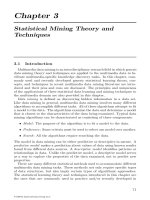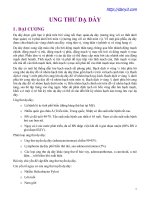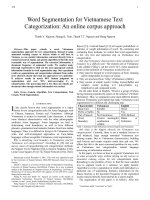Tài liệu Helpful Hints for Clean-Up pdf
Bạn đang xem bản rút gọn của tài liệu. Xem và tải ngay bản đầy đủ của tài liệu tại đây (609.71 KB, 7 trang )
Helpful Hints for
Clean-Up
Author: Unkown
Artist: Philo Barnhart
Tips you can learn from almost any experienced clean-up artist - Inbetweener or Assistant.
1
PDF provided by www.animationmeat.com
Author: Jennifer Gwynne Oliver
Artists: Philo Barnhart & Jennifer Gwynne Oliver
Part One: Drawing for Animation
Construction (Done in Red or Blue or whatever color the xerox or digital scanning process can ignore)
Even though it’s a cartoon, think of it as having a skeleton and muscle - not just an assemblage of lines!
When starting a new character, read over available model sheets - noting any "formulas" ( ie : Mickey is 3 heads high, Mcleaches eyes are
one eye width apart, Bernards are 1 1/2).
If you have time, go over the model sheets and draw the character’s basic construction ( see illustration). This will help to familiarize you
with the character’s proportions.
Draw through shapes - objects.
Watch the ends of your lines, they determine the entire shape. (Draw through both connecting shapes and solid objects, feel the form as
you draw).
Simplify
Avoid Parallels and twinning, they create stiff, flat drawings.
Avoid tangents - they fool the eye into seeing unintended shapes. They also cause individual shapes to blend into one
another.
Create a strong silhouette - If you blacked in the drawing would it still read?
Avoid ambiguity - the "kinda, sorta, maybe" that makes areas mushy and uncertain. Create a drawing that is solid, not timid!
Avoid the "sawtooth effect" and monotonous lines. Vary clumps of hair, length of lines in clothing, skin folds etc.
Where’s the focus? Spend the most time and effort in the area(s) of focus (ie: The face - eyes especially, or hands if
they’re involved in some business).
Know where to put your money - You can speed up on fast action scenes, but take your time on slow acting scenes
and tracebacks.
Perspective- Are you using overlap in the right places to create proper perspective? One layout artist had the simplest
perspective lesson around: find your horizon line - what’s above it is up - what’s below it is down. So simple it’s easy to forget!
Don’t feel limited by the flat, two dimensional nature of the paper. If you need help visualizing it as three dimensional space try
drawing a box for your character to stand in.
Action lines ( especially useful in rough animation and key cleanup) When creating or recreating a ruff, find the basic action
line and build your drawing around it.
These drawings also show an effective use of silhouette - the action is clear even without the inner details.
Straights against curves create interest and tension.
2
PDF provided by www.animationmeat.com
Extreme-Extreme
Inbetweening
There are no insignificant drawings! The eye can percieve up to 1/30 of a second - your drawing will be on the screen 1/24 to 1/12 of a second.
Your inbetweens can make or break a scene!
Flip,flip,flip - rolling the section you receive, then flipping the drawings while you inbetween is essential to successful drawings.
Watch your arcs! - Plot arcs in red or blue before roughing in the character.
Check the layout- Are the characters feet well planted? Does the character have to register to any background elements, or elements on a
separate level?
Volumes- Another key to successful inbetweens is maintaining volumes. You may squash or stretch a shape but unless the volume of that
shape is kept consistentthe area wil "breathe". An exception to this rule is when the ruff animation dictates a change in volumes for animation
purposes. Some examples would be as Ariel reacts to an explosion; her eyes widen and the pupils contract with fear. Her hair also bristles
and her fingers appear longer and thinner. Another example is Roger Rabbit as he pulls his hands free of the baby carriage. His hands grow
disproportionately large for three frames. you don’t really see these drawings while viewing the action but you "feel" them. (Note: Always
check with your assistant or animator beforechanging any volumes for animation purposes)
Stay organized - Work out a system and know your scenes status at all times.
Communicate - Ask questions, listen to the answers. Ask your assistant or animator if there is anything specific that they want you to
watch out for when beginning a new scene. Ask to review a tape of the rough animation. Lack of communication breeds suspicion in the unit.
Don’t re-invent the character - Stick by the assistants keys and the model sheets. Any "additions" or "subtractions" of your own
will create glitches in the animation.
Pay close attention to the dialog - Sometimes it’s "on frame" and sometimes it’s a frame ahead. Check the keys against the X-
Sheet.
Use of top and bottom lights - Don’t use just one or the other, but both at your discretion. Best results; Bottom light for Blue
sketch, top for Black, Top and Bottom for close inbetweens.
Watch for lost details - such as whiskers, sep lines , and costume details.
Follow thru or Secondary action - Watch for areas with "drag" - often indicated by separate charts on the keys or ruffs. Areas
such as whiskers, hair, clothing, long ears (Roger Rabbit), usually have some type of delayed action during a fast moving scene.
3
PDF provided by www.animationmeat.com
LINE
"Think Shape not line!"
This doesn’t mean that line quality is unimportant! It means that when laying down your line you should think of yourself as a sculptor, sculpting
out your shape and defining it with a clean, simple , consistent line. Using a nice, smooth line will help to avoid "crawling" or "popping" against the
surrounding drawings.
Leads of pencils
A .03 is preferable. Start with an HB lead, if your line is too light, try a B. If it is to heavy or "hairy", try and H.
"Lazy" Lines often seen in tracebacks will make a constructed drawing seem flat. Use both top and bottom lights to help avoid them.
Connect all lines! The color will literally leak out in digital ink and paint systems. Make ink and paints job easier and check your
drawings for gaps. (That is unless the style of the picture is very loose).
Straight against Curve - Use straight lines for tension, strength, hard areas like knees and elbows. Curves for flow, sag and softness.
Let them play off one another, as they do in nature.
Varied Lines- If you’ve mastered a consistent line, then you must try to slightly darken your lines on objects that are closest to the viewer to
bring them forward.
4
PDF provided by www.animationmeat.com
Abbreviations and Terms
Dope Sheet or X-sheet - the exposure sheet on which frame
numbers, dialog and drawings numbers are written.
Dial - dialog
Bal- the "balance", whatever is not indicated by a separate chart. (ie: a key
has a chart for "Right arm" - everything that is not the right arm is the balance).
T/B - Traceback ( a drawing traced back from the previous one)
Ruff - Rough animation drawing
Folo- follow
Reg- Register the character to the background or other animation drawings)
BG - background
TP- Top Pegged
Seps- color separations for ink and paint (tone mattes,rouge on cheeks etc.)
Reading Charts
Circled number = Key
Underlined number = Breakdown
a number alone = Inbetween
5
PDF provided by www.animationmeat.com
Using Ruffs I
"Use your model sheet for proportion and details, the rough is for everything else". The rough determines the exact placement of the character,
as well as his/her attitude (Although you should do what you can to plus this , if possible.)
Keep your proportions consistent throughout the scene. If you are keying it try going from #1 to #53 to #106 (for a scene with 106 frames). Then
break it down, instead of keying it straight ahead.
Write dialog on the top of your drawing (right hand side) in a non photo pencil - underlining the sound or letter used. Ex: "prefer" , "The ". Don’t
forget to write the drawing number alongside as well.
Where to put your money II - Some characters take more care than others. For example jessica Rabbit or Mickey take more concentration than
Max the Dog or a fast moving Roger Rabbit, which can be handled more loosely. Facial features should always be given more attention than hair
or clothing.
Additional Tips
To make a change with a a fresh eye - flip the drawing over and view it using your bottom light. Seeing your drawing
backwards will give you a new viewpoint on your drawing, making it easier to find trouble spots. make your changes
on the back as well.
Don’t forget to rub down the backs of all your drawings - this helps avoid "dirt" on the surrounding drawings which
would have to be dealt with later in digital ink and paint. Clean the backs of the roughs you receive as well.
Report to your assistant (assistants to production manager as soon as the scene is finished. Another scene is
probably waiting!
Rifle is left for effects
Rifle is left for effects
A note on Eyes
Watch perspective!
A crease showing the thickness of the eyelid can help with eye
direction.
On some characters lifting the pupil slightly away from the
white will strengthen focus.
Indicate eyelashes on male characters with a darker line and
slight overlap for depth.
Make certain that eyelids are hinged on outer corner - not like
a pull blind.
6
PDF provided by www.animationmeat.com
Using Ruffs II
Another excellent drawing from the hand of Glen Keane - Rough but expressive!
Tackling roughs without Model Sheets -
If you are cleaning up your own character , or one that has never had a Model Sheet ( such as the prison animals in the "Rescuers Down
Down Under" ) research all that you can before you start - flip through the scene, noting details that pop up. Also consult model sheets of
similar characters.
Intimidating Rough? Try blocking out the basic shapes and drawing through them ( See construction notes on Page one). Rub your
drawing down with a kneaded eraser before laying in any details - refrain form over detailing. If you are debating about a line , leave it out.
Watch that shapes don’t "pop" from the front to the back. The shapes should naturally rotate into place in 3D space. By paying attention to
to the shapes on the surrounding drawings and drawing through the character you will be able to solve most problems you encounter.
Teeth or no teeth? Sometimes there is a debate over whether or not to expose a character’s teeth for certain sounds - especially for those
that don’t show teeth on their model sheets (ie: Wilbur). Consult with your Character Key on this - usually teeth are exposed for "s","v","f",
"th" etc.
Sometimes the key you should clean-up first isn’t #1 - try to find a drawing which provides a good representation of what the scene is about
and the attitude of the character.
Michelangelo was once asked while sculpting a house out of marble how he approasched the task. "I simpley remove what is not a horse"
he replied. This is something to keep in mind during cleanup. - removing from the rough what is not the character and adding what is.
(Unfortunately not as easy as it sounds!)
If this area were sawtoothed.
Avoid hair groupings which twin each other in
repetetive sawtooth like patterns. Try varying
the width and length of the hairs in a more
natural pattern.
Fig 1. Rough
Fig 2. Block out basic shapes
Fig 3. Final Clean-up
7
PDF provided by www.animationmeat.com









